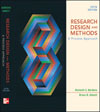 |  Research Design and Methods: A Process Approach, 5/e Kenneth S. Bordens,
Indiana University/Purdue University - Fort Wayne
Bruce Barrington Abbott,
Indiana University/Purdue University
Chapter 3 OutlineReasons for Reviewing the Literature
Sources of Research Information
Books
Scholarly Journals
Conventions and Professional Meetings
Other Sources of Research Information
Performing Library Research
The Basic Strategy
Research Tools
Using PsycInfo
Narrowing Your Search
A Note of Caution About Using PsycInfo
Other Computerized Databases
Computer Searching the Card Catalog
Reading the Literature Critically
Evaluating the Introduction
Evaluating the Method Section
Evaluating the Results Section
Evaluating the Discussion Section
References
Factors Affecting the Quality of a Source of Research Information
Primary versus Secondary Sources
Publication Practices
Consistency with Prior Knowledge
Significance of the Contribution
Editorial Policy
Peer Review
Problems with Peer Review
Fraud and the Role of Values in the Research Process
Fraud in Research
What Constitutes Fraud in Research?
The Prevalence of Research Fraud
Explanations for Research Fraud
Dealing with Research Fraud
The Role of Values in Science
How Values Influence What and How Scientists Study
Interpreting Behavior
Moving from What is to What Ought to Be
Developing Hypotheses
Summary
Key Terms |
|



 2002 McGraw-Hill Higher Education
2002 McGraw-Hill Higher Education